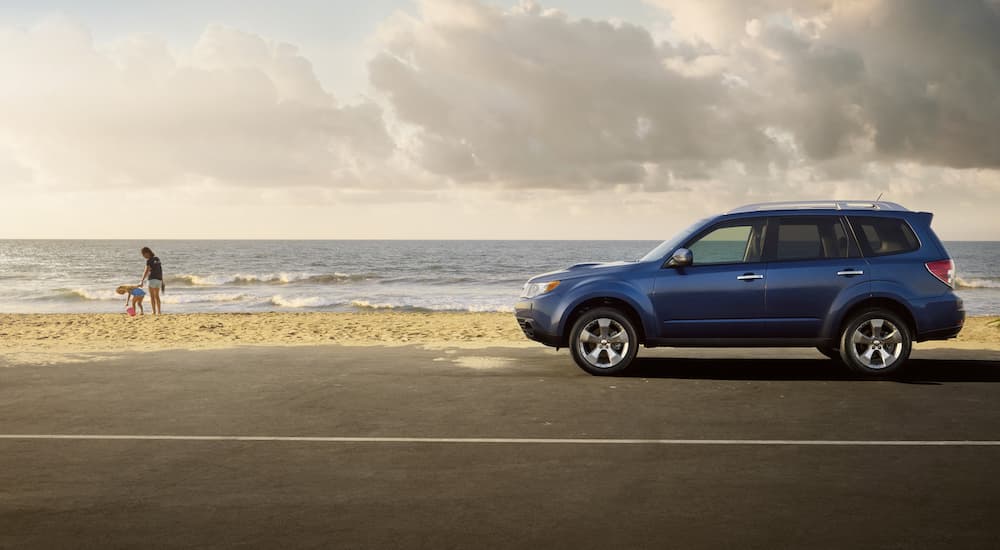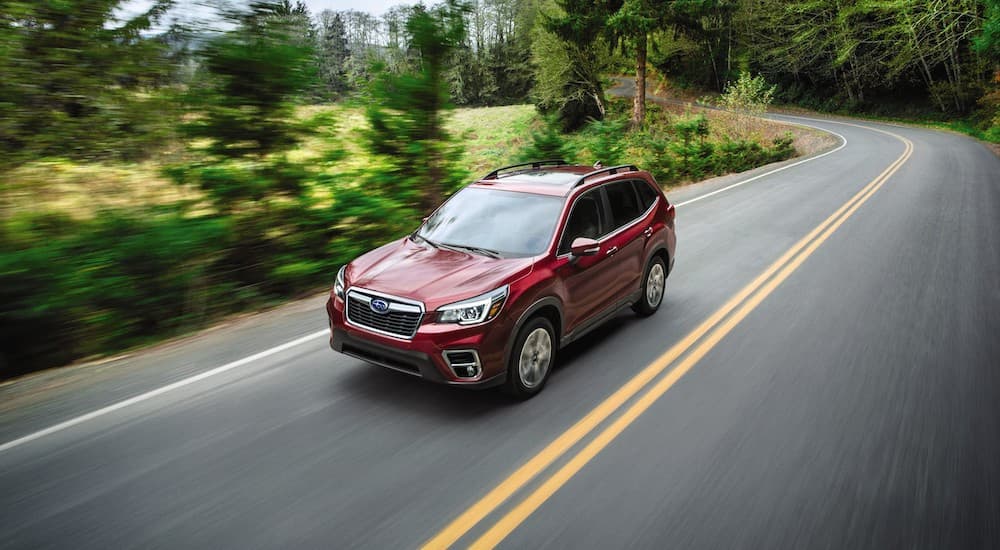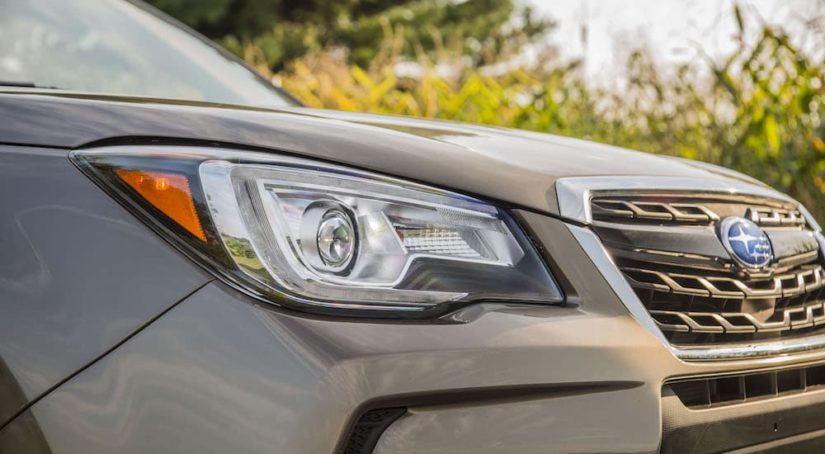The Forester is a model that has been in production since 1997, so you’ll likely see plenty of them while browsing at a used Subaru dealership. But what should you look for when buying a used Forester—and how do the models differ from year to year and trim to trim? That’s what we’ll be looking at in this buyers’ guide. So if you’re interested in this compact crossover, read on and take a look at what the popular Subaru entry has to offer—and which features you should keep an eye out for.
Generations
Vehicles like the Forester can see updates and changes from year to year, but generations mark major design overhauls that involve more substantial changes than the typical addition of a few extra tech features or a new paint color. As of today, there are five generations of the Subaru Forester. The first generation (model years 1998-2002) was a completely different body type from the modern Forester (a station wagon rather than a crossover SUV). The second generation (model years 2003-2008) got some new engines and refinements but didn’t accompany a fundamentally new design.
Kicking off the third generation, the 2009 Forester is definitely categorized as an SUV, and it was praised upon debut for being a more fuel-efficient option than most SUVs. Meanwhile, it was plenty capable, with standard all-wheel drive and a solid towing capacity.
Generation four of the Forester, which began with the 2014 model, brought even more efficient powertrains, along with more space for passengers and cargo and upgraded tech. 2017 saw some style upgrades, including a new front bumper, grille, and wheel design.
If you get a 2019 model or newer, you’ll be getting a Forester from the fifth and most recent generation. The platform that debuted for the 2019 model year was both stronger and lighter than those of previous generations. The new design also makes the interior roomier while still maintaining the compact exterior that makes the Forester easy to maneuver. This generation did drop two options that were available previously: a turbocharged engine and manual transmission. Most drivers won’t miss either, but enthusiasts who want them should stick to 2018 models or older.

Trims
Trim levels haven’t changed too much over the years since the Forester has been in production. A few new trims and special editions have popped up here and there, but overall they’ve been pretty consistent. Four levels you’ll find in most model years are the Base, Premium, Limited, and Touring:
- Base is, of course, the most basic option and also the most affordable.
Premium comes with more features, which generally include comfort features like heated seats as well as exterior style upgrades like body-color side view mirrors, though the specifics vary from year to year. - Limited has an even more luxurious interior with leather upholstery and also comes with more technology. For example, the 2020 Forester Limited comes standard with blind-spot monitoring, a power liftgate, and steering-responsive LED headlights.
- Touring, the top level, carries most of the benefits of the lower levels plus a few extras. For example, the 2021 Touring has not only heated front seats, but heated rear seats too, plus reverse automatic braking, LED fog lights, built-in navigation, and an upgraded audio system.The Sport trim was introduced for the 2019 model year, and it fits in between the Premium and the Limited. As the name suggests, this trim is geared toward driving enthusiasts, debuting with features like larger front disc brakes, larger wheels, and paddle shifters. If you’re looking for the Wilderness trim, which has more off-road capability, a higher towing capacity, and a rugged appearance, then you may be disappointed. The Wilderness was a new addition to the trimline for the 2022 Forester, so it will probably take a while for a significant number of them to make their way onto used car lots.
Safety
The Forester has a long track record of being highly-rated in terms of safety and crashworthiness. Since the 2007 model year, every Forester has been named either a Top Safety Pick or a Top Safety Pick+ by the Insurance Institute for Highway Safety. From the current model year all the way back to the 1999 Forester, you’ll only find 4- or 5-star overall safety ratings from the National Highway Traffic Safety Administration, and from 2014 onward it’s all 5-star overall ratings.
While even decades-old Foresters are crashworthy and equipped with safety measures like multiple airbags and standard daytime running lights, newer models are going to have more high-tech safety features to offer. Subaru’s EyeSight driver-assistance system has been loaded with features like pre-collision braking, lane-departure warning, and adaptive cruise control as far back as the 2014 model year. However, it was an optional add-on for years, so not all older models are equipped with it. For the 2019 Forester, EyeSight became a standard feature on all trim levels.
Technology
This is a category that tends to change at a faster pace than others, so if certain tech features are must-haves for you, it’s important to pay close attention. Since technology not only varies from year to year and from trim to trim but is also sometimes relegated to optional packages, it’s worth asking what features the specific used vehicle you’re looking at is equipped with. But here’s a quick overview of what tech you can expect to find in fourth- and fifth-generation Foresters.
The 2014 Forester comes standard with Bluetooth, so you can wirelessly stream content from your smartphone. A rear-vision camera comes standard on all trims except the Base model and a touch-screen navigation system is standard on the Touring, though it’s also available on the Premium and Limited. For 2015, hill descent control became a standard feature on Limited trims and above. By the 2016 model year, every trim level comes standard with a touchscreen infotainment system and backup camera. 2019 Foresters and newer all come standard with a comprehensive suite of technology, including Apple CarPlay and Android Auto compatibility, trailer-stability assist, an electronic parking brake, automatic climate control, and a rearview camera washer that comes in handy on dirt roads.
Fuel Economy
The Forester may be considered an SUV, but its compact size and efficient powertrain give it impressive fuel economy. Foresters from 2019 to 2022 have an EPA combined city/highway rating of 29 MPG. Foresters from 2017 and 2018 are slightly less fuel-efficient at 28 MPG and model years 2014-2016 fall just behind at 27 MPG, which is exactly what the average 2022 vehicle earns, according to the EPA. Go any older than that and there’s a steeper dropoff; the 2013 Forester gets only 23 MPG. As long as you stick to the fourth or fifth generation, you can rest assured that you won’t be feeling too much pain at the pump.
However, this is assuming that you’re looking at a vehicle with an automatic transmission and non-turbo engine. This is the only option available for 2019 models and newer, but is worth watching out for on older models. The 2018 Forester with the turbo engine only gets 25 MPG and the 2018 with manual transmission gets 24 MPG. This trade-off might be worth it if you’re looking for the extra power the turbo provides—or prefer driving a stick shift, but drivers looking to attain optimal fuel economy should avoid these variations.

Final Thoughts
As a reliable vehicle that’s built to last, the Subaru Forester is a great choice for used car buyers. In fact, data from Experian shows that 97% of Foresters sold in the last ten years are still on the road today. If you’re looking for the latest technology, you’re better off sticking to vehicles from the fifth generation, and you may want to consider opting for a higher trim level. If you’re more old-school and are looking for manual transmission or a turbo-powered engine, you’ll want to keep an eye out for fourth-generation Foresters or older. No matter what version you end up with, you’re sure to have a quality ride that will serve you well for years to come.



